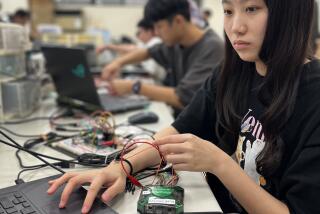Surge in Sales of Chips Expected
- Share via
Anticipated strong sales of personal computers, cell phones, digital cameras and wireless computing systems are expected to produce healthy gains for the semiconductor industry in 2003 for the first time in years.
After plummeting 32% in 2001 and registering a paltry growth rate of 1.3% last year, computer- chip revenue is projected to come out of its slump as corporate buyers return to the market.
Chip sales should grow to $169.3 billion in 2003, up about 20% from $140.7 billion in 2002, according to the latest forecast from the Semiconductor Industry Assn., a trade group based in San Jose.
“We expect the momentum built throughout 2002 in both cell phones and PCs to increase in 2003,” said SIA President George Scalise. As a result, he added, the group believes that spending on technology hardware will register an increase for the first time since 2000, driving chip sales.
Intel Corp., the world’s largest computer-chip manufacturer, is confident that new products, booming growth in Asia and large-scale replacement of aging computers bought to avoid the Y2K bug will drive its business in 2003.
Other semiconductor makers say they are similarly optimistic about those trends, despite gathering war clouds.
“I look around, and consumers seem to have a lot of confidence,” said Mark Bode, client brand and launch manager for No. 2 chip maker Advanced Micro Devices Inc. of Sunnyvale, Calif. “Computer stores are busy. People are going to continue with their lives.”
Not that the prospects of war with Iraq or an armed conflict with North Korea have no effect on the market.
Geopolitical tensions already are seen as a drag on the economy. Nervous corporate customers and consumers alike may elect to keep their money in the bank instead of spending it on hand-held computers, two-way pagers and other electronics gear that is powered by chips.
“Uncertainty ... stops people from executing their plans,” said Risto Puhakka, vice president of VLSI Research, a technology market research firm. “Everybody wants to step back and evaluate what’s going on and wait for a while.”
That, in turn, could certainly put the brakes on the fledgling chip recovery.
“The lingering threat of a war will keep new orders for both communications and computer and electronics products challenging in the near term,” said Daniel Niles, a technology analyst with Lehman Bros. in San Francisco.
But not for long. Niles sees 2003 semiconductor revenue rising 13% to 15%.
Predictions of a chip industry turnaround in 2002 barely materialized because the economy didn’t grow as briskly in the second half of the year as expected. Corporate spending on information technology also remained anemic. But this year is set to be different. In a recent report, Merrill Lynch predicted that chip revenues would rise 12% to 13% in 2003, in part because inventories of chips needed to make PCs and wireless phones have gotten quite low.
“It will be difficult for the industry not to return to” robust growth this year, the investment bank said in its report. “We do not need a dramatic economic recovery to get to our numbers.”
Helping to make up for any war-induced sag in the U.S. market, executives say, is surging demand for chips in China.
Last year, the Asia-Pacific region surpassed the Americas as the world’s largest market for the semiconductor industry. Chinese and Southeast Asian consumers and companies are getting more wired, and computer use is spreading rapidly.
Alan E. “Lanny” Ross, the interim chief executive of communications chip maker Broadcom Corp., said last month that the Irvine-based firm’s China business could balloon to $1 billion annually in the next several years and eventually become a stand-alone company.
Intel’s revenue from China was 40% higher in the fourth quarter than the third quarter, and the Santa Clara, Calif.-based company expects the momentum to continue.
Chip producers also stand to benefit from the “Y2K refresh” trend. Companies are eager to upgrade the PCs they bought at the tail end of the 1990s because the older they get, the more expensive they are to maintain. New computers account for more than 35% of the demand for chips each year.
“Y2K-compliant PCs are now 3 years old,” and millions of them need to be replaced, said Dwight Decker, chief executive of Newport Beach chip maker Conexant Systems Inc.
The migration to the latest version of Microsoft Corp.’s Windows operating system and the need to run the latest software applications also are sparking an upgrade cycle, analysts said.
Meanwhile, demand for wireless chips also is expected to grow this year, especially in the U.S. and Asia. The emergence of cell phones with color screens, built-in cameras and other processing-intensive features should help fuel this slice of the market.
The continuing popularity of cell phones triggered a 13.2% rise last year in sales of flash memory chips that store data such as phone numbers and addresses. It also contributed to a 6.8% increase in sales last year of digital signal processors, which convert voices and other analog signals into data that can be stored or transmitted digitally, according to the SIA.
That growth could climb further in 2003 as more laptops offer the capability to network via wireless connections. What’s more, schools, airports and retail outlets are outfitting themselves to provide wireless computer access. For instance, more than 2,100 Starbucks coffeehouses in the U.S. boast wireless networks, according to the company.






